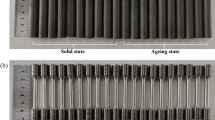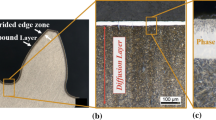Abstract
The axial loading test was performed to investigate the effect of carburizing on crack initiation and growth behaviors of a gear steel under high cycle fatigue (HCF) and very high cycle fatigue (VHCF). As a result, the carburized gear steel exhibits the duplex S–N characteristics associated with different interior failure mechanisms. The failure process in the HCF regime can be described as inclusion → fisheye → final crack growth zone (FCGZ) → momentary fracture zone (MFZ), whereas that in the VHCF regime is described as inclusion → fine granular area (FGA) → fisheye → FCGZ → MFZ. Based on the definition of crack sizes at different transition stages and the evaluation of stress intensity factor, the models for predicting crack initiation and growth lives in the HCF regime and in the VHCF regime were established. The predicted crack initiation life tends to increase with the decrease of stress amplitude. In the VHCF regime, the crack initiation life associated with the FGA size is almost equivalent to the total fatigue life, whereas the crack growth life only occupies a tiny fraction. In view of the good agreement between the predicted and experimental results, the theoretical modeling method based on crack initiation and growth can be well used to predict the fatigue life of carburized steel with the interior inclusion-induced failure in the HCF regime and in the VHCF regime.














Similar content being viewed by others
References
B. Chen, B.X. Huang, H. Liu, X.L. Li, M.T. Ni, and C. Lu: Surface nanocrystallization induced by shot peening and its effect on corrosion resistance of 6061 aluminum alloy. J. Mater. Res. 29, 3002–3010 (2014).
Y.C. Peng, M.C. Zhang, J.X. Dong, and C.Y. Du: Investigations on carburizing mechanisms of Cr35Ni45Nb subjected to different service conditions in a high-temperature vacuum environment. J. Mater. Res. 30 (6), 841–851 (2015). doi: https://doi.org/10.1557/jmr.2015.46.
C. Bathias: There is no infinite fatigue life in metallic materials. Fatigue Fract. Eng. Mater. Struct. 22, 559–565 (1999).
K. Shiozawa, M. Murai, Y. Shimatani, and T. Yoshimoto: Transition of fatigue failure mode of Ni-Cr-Mo low-alloy steel in very high cycle regime. Int. J. Fatigue 32, 541–550 (2010).
W. Li, Z.D. Sun, Z.Y. Zhang, H.L. Deng, and T. Sakai: Influence of case-carburizing and micro-defect on competing failure behaviors of Ni-Cr-W steel under gigacycle fatigue. Int. J. Fatigue 72, 66–74 (2015).
S. Nishijima and K. Kanazawa: Step S-N curve and fisheye failure in gigacycle fatigue. Fatigue Fract. Eng. Mater. Struct. 22, 601–607 (1999).
T. Sakai, Y. Sato, and N. Oguma: Characteristic S-N properties of high-carbon-chromium-bearing steel under axial loading in long-life fatigue. Fatigue Fract. Eng. Mater. Struct. 25, 765–732 (2002).
Y. Murakami, N. Yokoyama, and J. Nagata: Mechanism of fatigue failure in ultralong life regime. Fatigue Fract. Eng. Mater. Struct. 25, 735–746 (2002).
K. Shiozawa, Y. Morii, S. Nishino, and L. Lu: Subsurface crack initiation and propagation mechanism in high strength steel in a very high cycle fatigue regime. Int. J. Fatigue 28, 1521–1532 (2006).
T. Sakai, M. Takeda, K. Shiozawa, Y. Ochi, M. Nakajima, and T. Nakamura: Experimental reconfirmation of characteristic S-N property for high carbon chromium bearing steel in wide life region in rotating bending. J. Soc. Mater. Sci., Jpn. 49, 779–785 (2000).
K. Shiozawa, L. Lu, and S. Ishihara: S-N curve characteristics and subsurface crack initiation behavior in ultra-long life fatigue of a high carbon-chromium bearing steel. Fatigue Fract. Eng. Mater. Struct. 24, 781–790 (2001).
Y. Murakami, T. Nomoto, and T. Ueda: Factors influencing the mechanism of surperlong fatigue failure in steels. Fatigue Fract. Eng. Mater. Struct. 22, 581–590 (1999).
C.R. Sohar, A. Betzwar-Kotas, C. Gierl, B. Weiss, and H. Danninger: Fractographic evaluation of gigacycle fatigue crack nucleation and propagation of a high Cr alloyed cold work tool steel. Int. J. Fatigue 30, 2192–2199 (2008).
Y. Yu, J.L. Gu, B.Z. Bai, Y.B. Liu, and S.X. Li: Very high cycle fatigue mechanism of carbide-free bainite/martensite steel micro-alloyed with Nb. Mater. Sci. Eng., A 527, 212–217 (2009).
Y.H. Nie, W.T. Fu, W.J. Hui, H. Dong, and Y.Q. Weng: Very high cycle fatigue behavior of 2000MPa ultra-high-strength spring steel with bainite-martensite duplex microstructure. Fatigue Fract. Eng. Mater. Struct. 32, 189–196 (2009).
T. Nakamura, H. Oguma, and Y. Shinohara: The effect of vacuum-like environment inside sub-surface fatigue crack on the formation of ODA fracture surface in high strength steel. Procedia Eng. 2, 2121–2129 (2010).
P. Grad, B. Reuscher, and A. Brodvanski: Mechanism of fatigue crack initiation and propagation in the very high cycle fatigue regime of high-strength steels. Scr. Mater. 67, 838–841 (2012).
Y. Murakami and M. Endo: Effects of defects, inclusions and inhomogeneities on fatigue strength. Int. J. Fatigue 16, 163–182 (1994).
K. Tanaka and Y. Akiniwa: Fatigue crack propagation behavior derived from S-N data in very high cycle regime. Fatigue Fract. Eng. Mater. Struct. 25, 775–784 (2002).
Y.B. Liu, Y.D. Li, S.X. Li, and Z.G. Yang: Prediction of the S-N curves of high-strength steels in the very high cycle fatigue regime. Int. J. Fatigue 32, 1351–1357 (2010).
H. Mayer, W. Haydn, R. Schuller, S. Issler, B. Furtner, and B. Bacher-Hochst: Very high cycle fatigue properties of bainitic high carbon-chromium steel. Int. J. Fatigue 31, 242–249 (2009).
C. Sun, J. **e, A. Zhao, Z. Lei, and Y. Hong: A cumulative damage model for fatigue life estimation of high-strength steels in high-cycle and very-high-cycle fatigue regimes. Fatigue Fract. Eng. Mater. Struct. 35, 638–647 (2012).
M.D. Chapetti: Prediction of threshold for very high cycle fatigue (N>107 cycles). Procedia Eng. 2, 257–264 (2010).
A. Zhao, J. **e, C. Sun, Z. Lei, and Y. Hong: Prediction of threshold value for FGA formation. Mater. Sci. Eng., A 528, 6872–6877 (2011).
W.D. Pilkey and D.F. Pilkey: Peterson’s Stress Concentration Factors, 3rd ed. (John Wiley and Sons Inc., Hoboken, New Jersey, 2008).
I. Marines-Garcia, P.C. Paris, H. Tada, C. Bathias, and D. Lados: Fatigue assessment using an integrated threshold curve method—Applications. Eng. Fract. Mech. 75, 1657–1665 (2008).
K. Tanaka and T. Mura: A theory of fatigue crack initiation at inclusions. Metal. Trans. A 13A, 117–123 (1982).
G. Venkataraman, Y.W. Chung, and T. Mura: Application of minimum energy formalism in a multiple slip band model for fatigue—I. Calculation of slip band spacings. Acta Metall. Mater. 39, 2621–2629 (1991).
K.S. Chan: A microstructure-based fatigue-crack initiation model. Metall. Mater. Trans. A 34A, 43–57 (2003).
A.S. Cheng and C. Laird: Fatigue life behavior of copper single crystals. Part II: Model for crack nucleation in persistent slip bands. Fatigue Fract. Eng. Mater. Struct. 4, 343–353 (1981).
I.G. García, V. Mantič, and E. Graciani: Crack onset at the spherical-inclusion matrix interface. Application of a coupled stress and energy criterion. Procedia Mater. Sci. 3, 1336–1341 (2014).
P.C. Paris, I. Marines-Garcia, R.W. Hertzberg, and J.D. Donald: The relationship of effective stress intensity, elastic modulus and Burgers-vector on fatigue crack growth as associated with “fisheye” gigacycle fatigue phenomena. In Proc.VHCF-3, Kyoto, Japan. (Society of Materials Science, Japan (JSMS), Kyoto, Japan, 2004).
ACKNOWLEDGMENTS
This work was supported by National Natural Science Foundation of China (Grant No. 51305027).
Author information
Authors and Affiliations
Corresponding author
Rights and permissions
About this article
Cite this article
Li, W., Sun, Z., Deng, H. et al. Interior crack initiation and growth behaviors and life prediction of a carburized gear steel under high cycle fatigue and very high cycle fatigue. Journal of Materials Research 30, 2247–2257 (2015). https://doi.org/10.1557/jmr.2015.182
Received:
Accepted:
Published:
Issue Date:
DOI: https://doi.org/10.1557/jmr.2015.182




